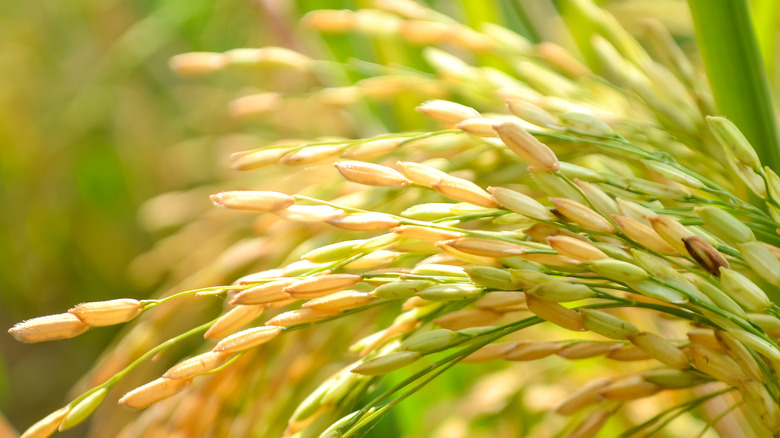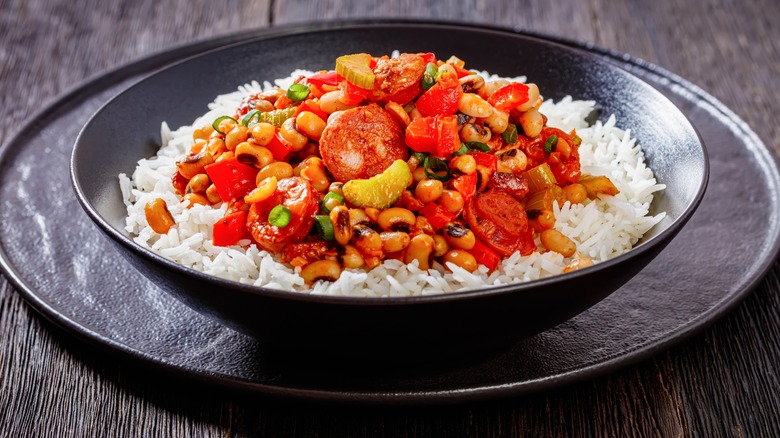The Storied History Of Carolina Gold Rice
Gold is the color of the rice variety reputed to be among the world's best. The name also suggests the financial impact of the crop, Carolina Gold, that made Charleston, South Carolina one of the wealthiest cities in the U.S. Sadly, that wealth did not extend to the slaves whose labor generated this windfall.
The Carolina Gold Rice Foundation describes Carolina Gold as the nation's oldest variety of rice. Lowcountry Local First attributes its domestic introduction to a sea captain, John Thurber, who paid for ship repairs with a peck of seeds from Madagascar. Carolina Gold developed as a potent cash crop in the late 17th century and soared in popularity within 100 years. Perfect growing conditions led to millions of bushels sold by the beginning of the Civil War. Per the South Carolina Encyclopedia, nearly three-quarters of the rice grown in the U.S. by 1860 originated in South Carolina, much of which was Carolina Gold. Money from exporting the rice filled the local coffers.
Hurricanes in the early 1900s devastated the crop, and Carolina Gold production ground to a halt in the 1920s, according to Undiscovered Charleston. It subsequently virtually vanished. Our State blames the decline on several factors in addition to the destructive storms. Muddy growing conditions encouraged a reliance on harvesting by hand and discouraged the use of mechanical equipment. Competing states could produce white rice at a prodigious and less expensive rate. And, an enslaved population was no longer available to grow and tend to the crop.
On the backs of slaves
Per the South Carolina Sea Grant Consortium, rice growing in Carolina's wetlands was not only labor-intensive but required knowledge of specific complex techniques. Countries such as Madagascar, Benin, Liberia, and Sierra Leone had similar growing conditions as Carolina's tidewater marshlands, and a populace experienced in cultivating rice. As a result, local traders concentrated their slave catching efforts in West Africa's so-called Rice Coast. Plant Humanities Lab asserts that gold rice was carried to the New World by these slaves, and also provided their sustenance during the crossing.
According to the National Park Service, female slaves planted the rice seeds via the traditional toe-heel method. Walking among the rows, their toes created holes into which seeds were dropped. The seeds were then compressed into the ground by their heels. Land was cleared and flooded at required intervals by enslaved people, and rice was hulled by them using mortars and pestles they constructed. The rice is a staple of the Gullah (also known as Geechee), the descendants of these slaves captured in West Africa and taken to America. Carolina Gold cultivators (slave and non-slave) also grew local specialties including benne, Sea Island white flint corn and red peas, red cevie beans, and Charleston Wakefield cabbages, per The Local Palate.
Carolina Gold bounces back
After its near extinction, Carolina Gold is making a comeback. Dr. Richard Schulze, Charles N. Bollich, and Glenn Roberts are names that figure prominently in its return. According to Savannah Now, surgeon and avid duck hunter Schulze cultivated rice to lure the birds. He decided to up the ante and attempt to grow the gold standard Carolina Gold. He obtained 14 pounds of seeds from agronomist Bollich, and in so doing, jumpstarted the rice's resurgence.
Glenn Roberts is the president of the Carolina Gold Rice Foundation. His company Anson Mills has grown heirloom Carolina Gold for 25 years, and now manages organic fields in four states. Its Charleston Gold seeds, a Carolina Gold hybrid, are aged with wild red bay laurel. An aromatic rice, similar to basmati, is the result.
The mature plant can reach a height of 5 feet. However, they can blow down, and gold rice is delicate and prone to breaking while being husked. BBC Travel reports that the broken pieces are called middlins, and are the focal point of many of today's recipes. They produce a texture akin to grits or porridge when cooked. Carolina Gold Rice has been variously described as creamy, nutty, sweet, earthy, chewy, and textural. The Slow Food Foundation for Biodiversity describes its hints of green tea and almond, and praises its unique starchy qualities. Carolina Gold is a versatile rice and the centerpiece of Creole favorites Hoppin' John, pilau, and Charleston red rice.


